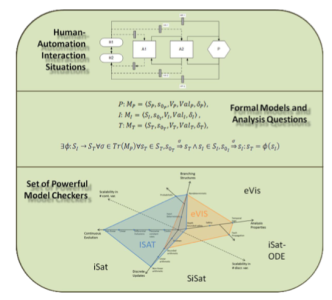Verification Models for Advanced Human – Automation Interaction in Safety Critical Flight Operations

Within VASCO the formal verification methodology (FVM) for advanced human- automation interaction in safety critical environments based on models of the overall human-automation interaction (HAI) system has been developed.
The main objectives for this work are summarized below:
- Approach human-automation interaction from a holistic cooperative system
perspective where the object of design is a system of human agents (operators) and machine agents (automated systems) jointly performing a series of tasks (e.g., acquiring data, computing trajectories) aiming at satisfying higher level global task(s) (e.g., controlling a spacecraft).
- Seamlessly allow to consider human factor issues during system engineering in order to build systems that support strengths and compensate limitations of human behaviour characteristics.
- Address the knowledge gathered from other industries on the source and nature of human errors in advanced automated systems in a systematic way.
- Provide an extensive list of analysis questions for HAI situations.
- Consider human errors based on automatic human error injection into the nominal
HAI system.
- Go beyond the analysis of prototypical HAI systems consisting of an operator, a user
interface, an automation system and a controlled process to arbitrary complex
systems with multi-level automation, multiple operators and interfaces.
- Evaluate the developed FVM on the basis of a case study.
- Propose recommendations for implementing the developed FVM into the design
processes at ESA.
The project focusses on systems from the space domain. However, the FVM should be generic and should allow transferring knowledge and experiences from other domains into the space domain. Furthermore a special focus is put on human factor issues that are very specific to systems that include automated tasks.
